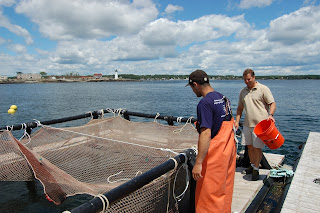With the current resource
problems facing the fishing industry, fishermen are often seeking way to
improve their efficiency. One method
that is gaining popularity among trawl fishermen is the use of acoustic gear sensors. Typically, fishermen rely on their knowledge
of how their boat works and feels to know how their net is behaving under
water. With the use of acoustic sensors
placed on the trawl gear fishermen can have a much better understanding of what
is happening under water to maximize their productivity and increase overall
efficiency.
Captain Jim Ford is a
fisherman out of Newburyport, MA and has been using sensors on his trawl gears
for the past four years. He has sensors
on the doors of his trawl gear, which are used to spread the net. While fishermen generally know by feel how
much they are spreading their net, Ford’s sensors provide him with real time
information, displayed on a computer screen, of how his doors are passing
through the water column. Ford also has
a catch sensor, sometimes two, in the codend of his net, the section of the net
that holds the fish that are caught. The
idea behind the catch sensor is to notify Ford when his codend is filled with
fish so that he can haul in the net, empty out the fish, and start a new
tow. Depending on what species of fish
Ford is fishing for, he sets the catch sensor to a maximum weight, say 2,000
lbs. When the codend is filled with
2,000 lbs of fish, a light goes off on his computer screen notifying Ford that
his net is full and that he can haul it in.
Sensors provide fishermen
with a better viewpoint of what is happening under water. Without a sensor a fishermen will pick a tow
time, say two hours, and only deviate from that time if they feel a large
change in the feel of their boat.
Besides feel, they have no way of knowing how full their net truly
is. They may catch all of their fish in
the first thirty minutes of their tow yet they will keep going for another hour
and a half to complete the two hours.
During this time they are decreasing fuel efficiency, reducing the
amount of fish they can catch, and decreasing their fishing efficiency. By having a sensor that notifies the
fishermen that their net is full they can know exactly where they caught the
fish so they can stay in that area and reach their desired total catch in a
shorter period of time. Fishermen
already know the ocean; sensors just give them a little added information that
improves the way they fish.










